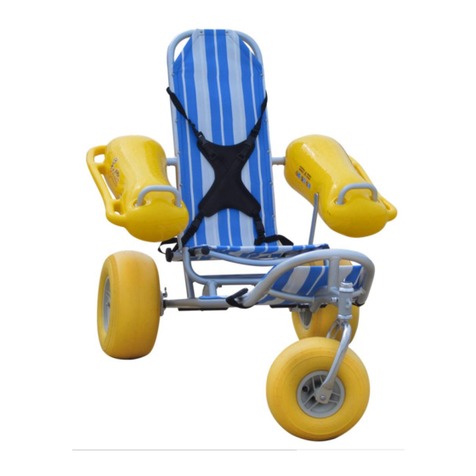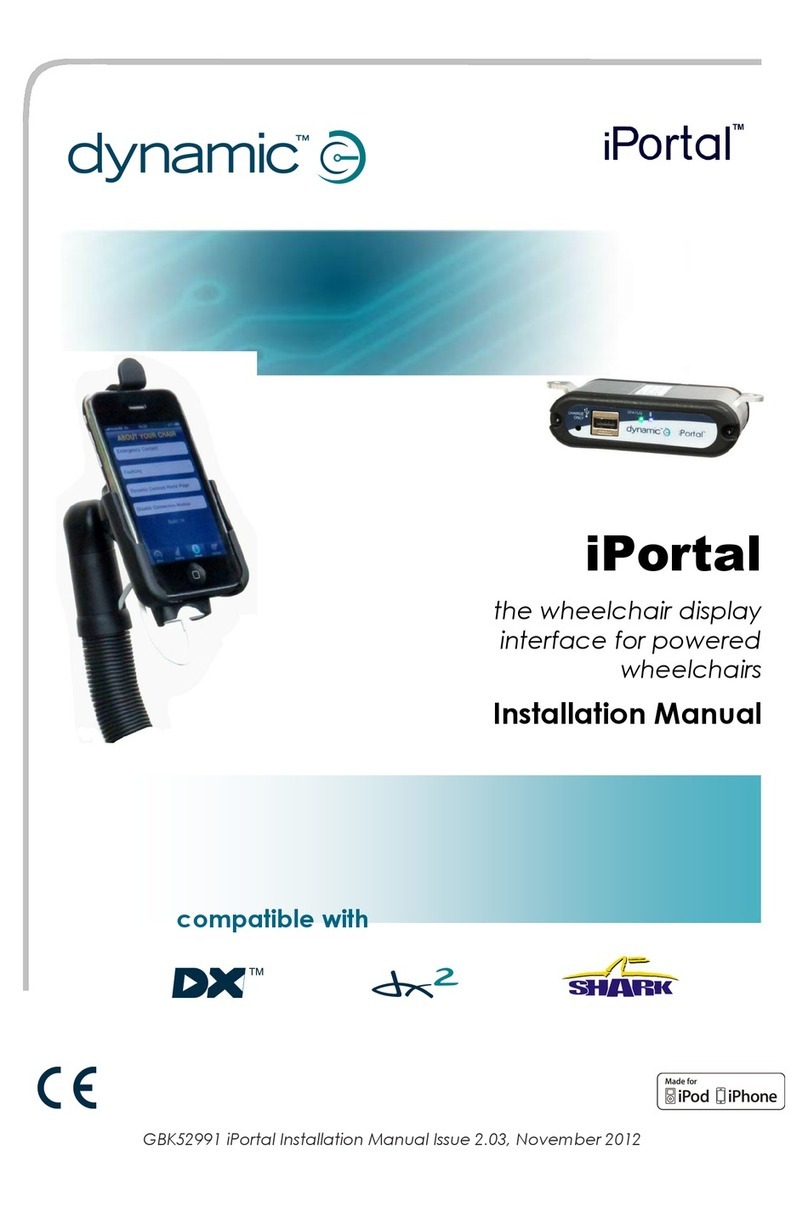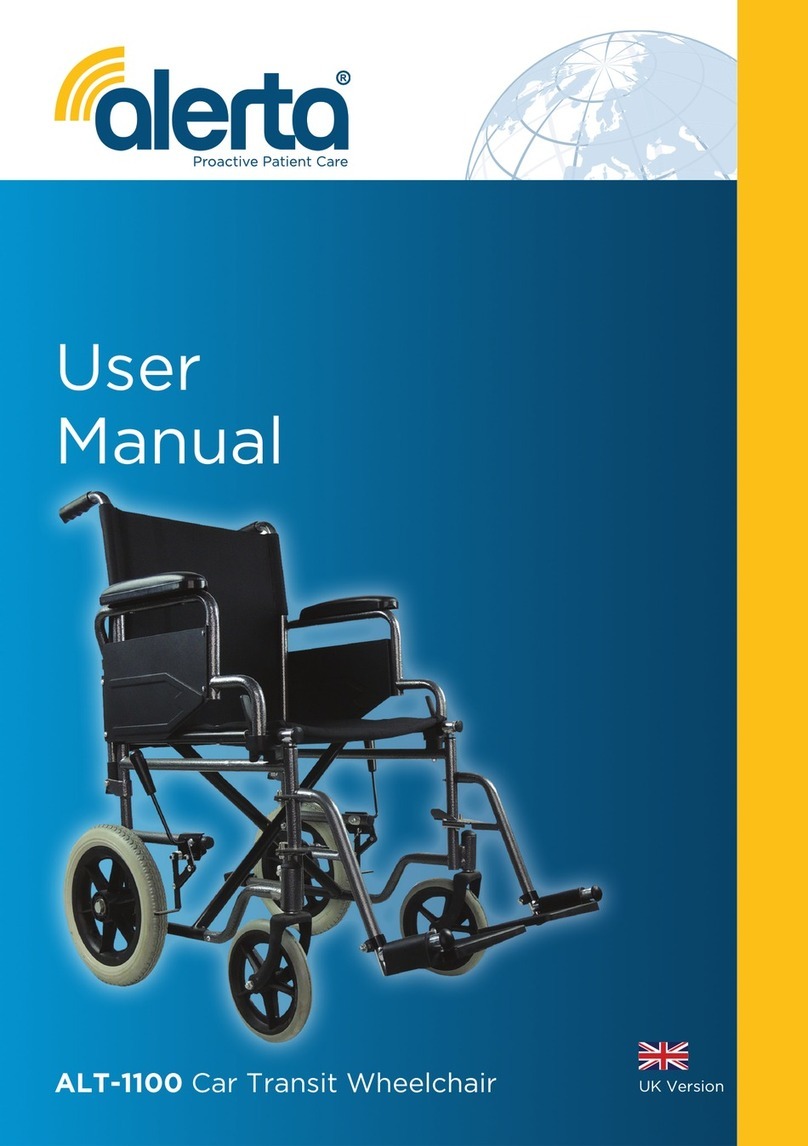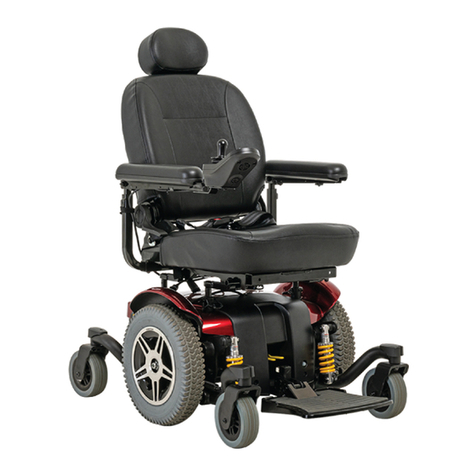
STABILITY
To assure stability of the wheelchair, it must be upright on its wheels and the center of gravity must be maintained in the chair. Several factors affect the
center of gravity and weight distribution of the wheelchair:
• Ramps, slopes & inclines
• Curbs, obstacles & soft grounds
• Added weight and addition of accessories
• User body movement, such as, bending and reaching
TRANSFER
Transfers require good balance and stability. Working with or receiving training from a therapist is essential before attempting to transfer on your own.
• Reduce gap between your wheelchair and the surface you are transferring to
• Engage the wheel locks
• Rotate the front casters forward
• Lift up armrests
• Remove or swing away the footrests
• Do not stand or apply weight to the footrests
OPENING THE WHEELCHAIR: Tilt wheelchair to one side toward you and push down on seat rail until fully opened. Lift notched part of the stabilizer
bar and push onto the stabilizer connection bar on the back cane. Tighten knob.
FOLDING THE WHEELCHAIR: Loosen knob on notched side of stabilizer bar and lower stabilizer bar. Fold footplates up to the vertical position. Grasp
the front and back edge of center of the seat upholstery and lift seat up.
HEADREST WITH NECK SUPPORT: Insert headrest into the top of the back canes. Neck Support can be placed onto the headrest and secured behind it.
WHEEL LOCKS: Push forward toward front of chair to lock. Wheel locks should embed into wheel at least 1/8” when locked. Engage
both wheel locks before entering or leaving the wheelchair, leaning forward or during transfer.
INSTALL SWING-AWAY ELEVATING LEGRESTS: Hold the legrest rigging to the side of the wheelchair. Install the legrest assembly hinge plates onto
the hinge pins of the wheelchair frame. Push the legrest rigging towards the inside of the wheelchair until it securely locks into place.
REMOVE SWING-AWAY ELEVATING LEGRESTS: Fold footplates up to the vertical position. Release legrest lock and swing legrest outward and to the
side. Remove legrest off the hinge pins and remove.
ADJUST LEGREST LENGTH: User should be sitting in wheelchair with feet on footplate when adjusting legrest length. Lift toggle on legrest clamp, press
push pins and raise or lower foot plate to desired position. Push pins should lock into place. The footrest should not be lowered to the point that it causes
pressure on the thighs at the front of the seat upholstery. A 2.5” clearance from the ground should be maintained to ensure proper clearance.
ADJUST LEGREST ANGLE: To raise legrest, lift footplate to desired position and it will automatically lock into place. To lower legrest, pull back legrest
lever and lower footplate to desired position.
FLIP-BACK ARMREST: Press in armrest release lever and lift arm from front socket.
REAR WHEEL: To adjust rear wheel position, depress center hub and remove quick-release wheel. Select axle position, insert wheel until an audible click
is heard.
FRONT WHEEL: Front wheels can be adjusted to align with rear wheel position. To adjust the front wheel, loosen and remove bolt and place into the
desired position.
NOTE: The wheelchair is shipped with the seat factory set in the hemi-position.
ANTI-TIPPER: Remove endcaps from support tubes. Press push pins and insert anti-tippers into the support tube. Push pins should lock
into place. A 1.5” to 2” clearance from the ground should be maintained to ensure proper clearance.
CARE
• Wheelchair should be washed weekly with a clean, soft cloth using warm water and a mild detergent. Dry thoroughly after washing.
Metal parts can be cleaned with auto wax or similar products.
• Do not use abrasive cleansers.
• Dry wheelchair immediately if exposed to moisture.
• Clean upholstery with a mild soap solution, rinse & wipe dry.
• Clean hand grips with water only and dry thoroughly.
• Occasionally clean front & rear tires with damp cloth.
• Inspect wheelchair to ensure:
• There are no evidence of cracks/damage to the wheels
• There are no splits, tears or worn spots on upholstery, armrest and handgrips.
• There are no broken or loose fixings, screws or nuts, sharp edges or bent frame
• Ensure that wheelchair rolls straight, legrests lock securely into place when attached and wheels are not warped or cracked.
3 YEAR LIMITED WARRANTY
This warranty is solely for the benefit of the original consumer
purchaser and is in effect from date of purchase.
Circle Specialty Inc. warranties that the Ziggo Pro wheelchair frame will be
free from defect for a period of three (3) years.
Circle Specialty Inc also warranties the parts, components and upholstery on the Ziggo wheel-
chair to be free from defect for a period of one (1) year. The warranty does not extend to
non-durable components, such as, rubber accessories, tires and grips.
This warranty does not cover device failure due to owner misuse or negligence. It only applies
when product is used according to the specified conditions and for the intended purposes.
If within the warranty period any such product shall be proved defective, such product will be
repaired or replaced at Circle Specialty’s option.
If you have a question about your Circle Specialty wheelchair or this warranty,
please contact an authorized dealer.
Circle Specialty, Inc.
Brooklyn, NY 11232, USA
718.943.6452
info@circlespecialty.com
2021/Rev 11-21






















